National Latino Writers Conference (Albuquerque, NM) Keynote Speech
Rigoberto GonzálezMay 20, 2010
Before I begin I would like to thank the organizers of the National Latino Writers Conference for inviting me to participate this morning as the keynote speaker at this exemplary gathering. This is the 8th year of building community, of fostering creativity and critique, and of guiding early-career writers toward mentorships and professional relationships with established writers whose generosity and insights are shaping the next generation of artists. To be honest, there is nothing unusual about these expectations at any writers conference, and there are dozens that take place across the country--most of them perfectly competent and useful. But what makes this conference so unique is that it is ours--a forum that has facilitated the face-to-face communication between Chicano/Latino writers, readers, and thinkers. And for that, I congratulate all of you who have sacrificed time and resources to contribute to that experience.
The year is 2010. And though we are currently standing beneath the shadow of the anti-immigrant and anti-raza legislation of our neighbors in Arizona (and let us hope that the disease of xenophobia is not contagious), I am going to keep my message positive this morning because, despite these acts of hostility against our people, there is much for us to celebrate. And if we do not recognize our successes, if we do not toast our triumphs, then we surrender to the afflictions of inferiority, invisibility and silence--the three disgraces of American politics and culture.
The year is 2010. To our left we have the U.S. Census, which will confirm for the country what we have always known when we wake up in the mornings to see the Aztec sun casting its rays over Aztlán: that we are plentiful, that we are here, that we are never leaving, that we will not be thrown out. To our right, we have the smoky memory of revolution, the cycle come back to the days of reckoning--1810, 1910, 2010--not only have we populated this land, we have also shaped its language, built its cities, spun its tales and written its songs. This is, indeed, nuestra tierra and we will keep the roots of our family and history embedded deeply into its indigenous and mestizo core.
But now come the important questions: How will each of us accept that responsibility? How will we contribute to this movimiento during this critical period of adversity? How will we know that we are marching on the correct path?
Since I am speaking in front of a group of poets and writers, I will speak to the answers through a cultural lens, acknowledging one of the greatest strengths of our community: its artistic muscle. Art and poetry, danza y teatro, cuento y canto, have always been essential components of the Latino cultural identity. From the pachanga navideña to the quinceañera, from the floricanto to the academic encuentros, we express ourselves through the arts because it is who we are: people who value creativity and imagination. Just look around you: the colorful palette of our folklore, the ingenious architecture of our altars, the linguistic textures of our slang, our names, our adivinanzas, the panoramic flavors in our foods, the range of decibels in our music, our cyber-chisme, our rascuachismo--it is all us all up in here, Senator Jan Brewer.
The impulse to dance and sing and, yes, the impulse to write it all down, to record and remember, is as natural and familiar to us as the impulse to breat
This week, La Bloga is happy to share late-breaking news and views from the National Hispanic Cultural Center in Alburquerque NM, site of the NLWC. Click link above for datos.
Margaret Y. Luévano
Forty thousand square feet of vibrant images gazed down upon us. We, artists of words, gathered in the torreon to witness the fresco coming into creation, eight years in the making. We craned our necks upwards to witness the story documented before us -- Arabs, Jews, missionaries, slaves, Spaniards, virgins, indigenous mothers. They looked at us, their descendants, looking at them. Overwhelmed by the beauty, with the magnitude of the work, all we could do was stare.
On the eve of the Latino Writers Conference in Albuquerque we had come together from all over the county, writers in search of community. We were there to learn and share, gain strength to move forward in our writing lives. In this world so attached to labels that divide, the fresco reminded us that we are all a mixture of history, that we are the sum of our past moving forward to create the future.
The next morning Rigoberto Gonzazles echoed this sentiment in his keynote address to open the conference. First we must pay tribute to those who have paved the way, but we must move forward as artists in a time of crisis. We must challenge ourselves to take on the mantle given to us by our antepasados and be agents of change; we must act as role models for the upcoming generations and help develop in them the tools to shape the future; and we must not be afraid to step out of our creative worlds to become literary critics, for it is through literary criticism that we grow as a community in dialogue.
Afterwards, we disperse to our workshops -- memoir, travel writing, news writing, poetry, young adult writing, playwriting, short fiction, comedy, and mystery. For the next two and half days it is our mission to pay homage to our mentors, to learn from each other, and take what we learn here and transform it into wisdom that changes the world.
Daniel Cano. Death and the American Dream. Tempe AZ: Bilingual Review Press / Editorial Bilingüe, 2009.
ISBN: 978-1-931010-54-2 (cloth) 978-1-931010-55-9 (paper)
Michael Sedano
Charley Trujillo leans into his story. The historical Tiburcio Vasquez had been a fluently bilingual upperclass scion of a Californio familia on the mid-19th century Monterey peninsula. Vasquez ran afoul of the clash of
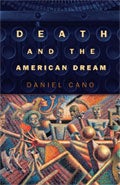
cultures--perhaps because he was too good at moving in and out of his hispanoparlante cultura and his equally educated Englich, I think—and went on the lam from la jura. Escaping a feared Mexican-killer lawman, Vasquez was pinched in West Hollywood by a local posse. In the newspapers of the day, Tiburcio’s personality won the day, but the jury hanged him anyway, no hard feelings, in 1875.
Trujillo, the author of
Soldados, and
Dogs From Illusion, writes with straightforward power about Chicanos in Vietnam, so his upcoming documentary film on this California legend should prove to be equally compelling. My conversation with Charley at the National Latino Writers Conference highlights the little-known, or mis-known, early history of Chicano culture in California. These people had storie
s; had newspapers, writers, an information culture, and that was a hundred years ago. So large a story, so small a memory.
Against that historical amnesia comes a much-needed historical novel, Daniel Cano’s Death and the American Dream. Next year marks the centennial of the 1910 Mexican Revolution, along with a starting point in the chronology of Mexican immigration into California. In Death and the American Dream, populated by an unusual protagonist supported by strong women, set against a convincing historical landscape, Cano treats his reader to six years in the life of a fugitive from the Mexican revolution who settles into a Mexicano community, not in East L.A., but a barrio that occupied today’s Brentwood on the tony west side.
Any title with “American Dream” in it has to be writ large, and the main problem with Death and the American Dream is it is writ too short. With success of this novel, it could become one in a series of historical novels tracking the conflicted biculturalism of that revolution-driven Chicano diaspora, in the person of Pepe Rios, who is not yet thirty as the novel ends in 1920. Pepe would be around 80 in 1970, the height of the Chicano Movement. It would be interesting seeing how Cano gets us there.
In 1911, eighteen year old Pepe Rios thrashes away from battle in Juarez to safety on the El Paso del Norte shore, where locals have set up picnics to take in the Mexican fireworks. Soldiering with Pancho Villa, Pepe gets tangled with the federales and believes he’s betrayed both his Villista compañeros and the feds, and killing his brother. Unable to tell his mother of his own role in the brother’s death, Pepe’s guilt launches him into headlong flight from the welter of confusions surrounding the battle and likelihood of execution by whichever side catches him first.
Crossing the river, Pepe kills an opposing soldier. Moving toward California, Pepe gets involved in killing a white man. Then Pepe’s best friend Seferino disappears into the hands of Los Angeles police and dies a suicide because he had it coming. These are the deaths that weigh heavily on Pepe—a son’s debt to his mother; the gallows; class and ethnic aporia--just as he’s about to get his first real taste of the American dream. The year is 1915. Pepe’s changed his name to José San Juan, and after years of subsisting on a steady diet of hard physical labor, San Juan—Cano always calls him Pepe--finds a dream job as a cub reporter at Martín Algodón’s newspaper, El ababar.
Cano puts strong women into Rios’ life. For his part, Pepe is not one of those “el hombre domina” tipos but willingly seeks his woman mentors. Ángela, the severe boss and cultural coach, continues where the priest left off back on el rancho, training the student’s mind. The alluringly beautiful Camilia, who years earlier has mentored Pepe Rios in passion, now his publisher’s wife, has gotten Rios/San Juan the life-changing break. Eusebia, a troubled woman, mother, and intimate confidant, disdains Pepe’s social whorl.
Mentored by seasoned bilingual veterana Ángela Durón, a writing career opens to the skilled letter-scribe and habitual diarist. Pepe hungrily takes to Ángela’s training. Secretly, he hopes one day to investigate Seferino’s murder, expose corruption, and bring a measure of justice to his “Just Us” excluded gente. Cano is spare but effective establishing the pervasive brutality of cop v. comunidad of the period, the Them and Us still extant. There’s no whining in Pepe’s bitterness. Cano allows Pepe and his neighbors seething outrage, moderated for similarly outraged readers by the dramatic irony that Pepe’s role is to be a tool. On one hand, the capitalist running dog Algodón keeps a willing Pepe on a financial leash. On the other hand, the anarchists cynically exploit Pepe, playing his ghosts against his better judgment, driving him to despicable and dangerous acts.
Language is no barrier to the monolingual Pepe. His beat is the newspaper’s society pages and occasional hard news piece. Los Angeles’ Spanish-speaking upper crust society opens to San Juan. Movers and shakers who love seeing their names and faces in the paper welcome the writer into their society, and Pepe’s a natural bon vivant and surreptitious interviewer. He gets good stuff that Ángela turns into interesting copy. Even without his own byline, other editors clamor for the reporter’s news. The money helps. With advanced skill, and notoriety, come danger. Ricardo Flores Magon comes to town to publish the famous Régeneración. In hot pursuit: the cops, the feds, the Mexican feds, judges, anglo media. Magon will eventually get 20 years that cost his life.
Home life offers little comfort to the fatigued and deeply stressed reporter. He’s out late at fancy events, often, in the company of attractive women who seem available. His wife aspires to none of Pepe’s social graces. Her values rest in her home, family, and gente. Eusebia recognizes her indianness as polar opposite to what draws Pepe out of the home. She understands her role. She brought her own children to marriage with Pepe. She knows as does he, that Pepe settled on her, still haunted by the memories of another woman. She recognizes the constant presence of the glamorous ex-lover, Camilia, in Pepe's career.
Cano’s description playing the two women against each other illustrates the dysjunction of Pepe’s torment. His wife has just looked into a mirror noting proudly her Amerindianness:
Pepe saw strength and beauty as he looked into her eyes—not a woman’s socially accepted beauty—bright eyes, curved lips, or shapely body—but something deeper, a chasm that lulled and puzzled at the same time, an enigma that transcended the flesh. Where Camilia, his ex-lover and now the wife of his employer, radiated beauty, intelligence, charm, grace, and poise, Eusebia exuded simplicity and dignity. She existed like the morning sun, a cloud, a wave, a puff of dust, or a blade of grass.
In an interesting writer's tack, Eusebia suffers mental illness. Deep bouts of depression leave her confused and angry. To his credit, Pepe doesn't blame Eusebia for her illness. He doesn't help her, merely tolerating her absences when depression seizes her and family life goes around her. To Cano's credit, he doesn't blame Eusebia either. Conventional writers would say, "pobre Pepe, married to a crazy woman." Eusebia has values, integrity, and thinks critically. Her illness is a fact of life that she manages as best she can. But the illness appears to be winning and we begin to lose Eusebia as a character. This mental illness motif adds interest and value to an already involving story, a unique instance of a good book doing good.
I understand that Eusebia has to play third fiddle to Ángela and Camilia. They stand for power and social mobility; Pepe's chosen slice of the dream. Eusebia connects to home, earth, fecundity, fragility; things Pepe takes for granted, or ignores. And Death and the American Dream, after all, is Pepe's story.
Pepe's workdays and nights bring him superficial contact with strangers. His only close personal connections include Eusebia and a friend he knew in the old days. Lacking much outlet, Pepe seethes in constant outrage at restrictive covenants in housing, heavy-handed lawmen, resentful English-speakers, his publisher’s willingness to publish lies that curry favor with industrialists and anti-unionists of both the US and Mexican governments. Already intoxicated by rubbing up against big shots, he doesn't notice his increasing taste for booze.
Pepe / San Juan becomes ensnared by the Magon movimiento. Ángela is one of the conspirators, and all along her mentoring has been directed toward Pepe’s recruitment. She reels him in like a fish on Santa Monica pier where Eusebia and Pepe met. The mentor tantalizes and torments Pepe with details of Seferino’s capture and suicide, with knowledge of that long-ago and far away killing. Pepe/San Juan becomes a spy for the Magones. When Ángela asks Pepe to use the publisher’s wife to spy on her husband, Pepe fails to recognize the organization’s manipulativeness. Instead his moral center spins ambivalently between getting the elegant former lover back into the sack, and betraying his obligation to Eusebia and their children. Tellingly, Pepe cannot make a convincing enough case for his wife’s side, but ends up driving the would-be lover into a towering rage that shatters their ties forever. Pepe is absolved of his responsibility to take effective action one way or the other. Is this as good as it gets?
Death and the American Dream is Cano’s second Pepe Rios novel. The eponymous 1991 title from Houston’s Arte Publico calls out “find and read me”, to learn how this current story fits into Cano’s earlier Rios story, and to observe a writer’s growth. This one’s a masterwork so the comparison will prove useful. While at the library, Daniel Cano’s Shifting Loyalties stands tall alongside Charley Trujillo’s as a must-read in United States war literature, and that of Chicanos in Vietnam combat.
The ending of Death and the American Dream will leave readers shaking their heads with surprise and mixed, mostly conflicted, emotions. Historical fiction has to follow the script, so there are no happy endings for Chicanas and Chicanos in 1920. Already the two older Rios boys are school dropouts; if it were 2009, they’d be skateboarders and asshole taggers. But it’s 1920 and the one is in and out of trouble, the other puts in hard physical labor but has begun spinning out of control. The older daughter has begun her own life, picking fruit up the central valley. Her kids will be in their seventies and eighties today, WWII veterans, Korean war vets, too, if she has as large a family as her mother. And medication is helping Eusebia's illness. But then, those are stories for another novel. Daniel?
Final Dispatch from Alburquerque...National Latino Writers Conference Wraps With Promise
I have been remiss and a poor guest in delaying thanking Carlos Vásquez and the National Hispanic Cultural Center for inviting my participation at the 2009 National Latino Writers Conference. Thank you, Carlos, Greta, Katie and the staff of the National Hispanic Cultural Center for a multi-faceted gem of a conference.
I presented a workshop on reading your work aloud and attended workshops on writing poetry, novels, cultural journalism, screenplays, memoir, children's picture books, and panels featuring publishers, editors, and agents. Saturday morning, I observed the interviews between individual writers and a publisher, editor, or agent. Present a quality work, make a convincing presentation and the writer takes another step toward publication.

Vásquez limits attendance to fifty writers. People attend from across the nation and literary ascendencias. Mexico and Puerto Rico gente attend in good proportions. This year included at least one Colombian, a couple Salvadoreños, and gente I didn't get to meet from otros países. Enrollment cost is a well-kept bargain secret, but transportation is extra. As a result there's a good contingent of New Mexico writers. The conference draws a multigenerational group, from college freshman to retirees, from ex-Marines to ex-GIs. Collegiality is probably the second-most valuable experience writers take home from Alburquerque. It is a hotbed of Chicana Chicano Latina Latino stimulating literary discussion.
Food service at the NHCC is unsurpassed. Registration includes breakfast, lunch, and banquet. Fruta, pan, burritos, salsa, come fresh to table. Main dishes taste and look good, presentation enhanced by attentive servers who don't let anyone down, even gente with food allergies and vegan writers. The conference program should list the mug shots and names of the key staff in that kitchen. ¡Ajua¡ to the cooks and servers.
Attention to detail--exemplified by the menu, the promptness and ease of getting everyone served and seated, but seen in all facets of programming--accounts for the smooth flow of the two and a half day literary festival. CPT rarely rares its head, events run on time. In the case of Open Mic, to the second.
Scheduling features tracks for fiction, poetry, movie, children, young adult writing, and the critically important panels. Two or more subjects are workshopped during ninety minute periods. Writers elect a course of study, following a topic or instructor, or sampling broadly as a way of enlarging their writer's repertoire of genre. Workshop presentations range from hands-on writing sessions to lecture-discussion variants.
Some instructors recognize the obstacle of offering more than token feedback and abandon the hands-on notion altogether. Reyna Grande, for instance, breaks a novel into five elements, then uses a metaphor of painting a canvas to discuss writing a novel.

Demetria Martinez does explication de texte, asserting that artifacts from everyday life are the stuff of memoir, then reading from Mother Tongue, where Martínez validates her assertion.
Some workshop leaders elect to conduct writing exercises, filling paragraphs or lists to fit schemata of a play, or a character, or a poem. Valerie Martinez, for instance, outlines a view of poetic sensibility, then distributes magazines and trinkets to foment vocabulary exercises that, who knows, could be, become, a poem?
There truly is not time to read or get feedback on one's exercises. Workshop leaders who engage enrollees in a lot of writing invariably collect the work and promise to read and get back to the writer. Thankfully for some, a modicum of feedback comes at the tail end of the ninety minutes. The best prepared writers, preferring the focused feedback of considered reading, as opposed to extemporaneous first impression, have mailed manuscripts in advance, for their Saturday interview. One improvement Vásquez and organizers might consider is widening this tarea model, with workshops springboarding from exercises completed prior to arriving.
One improvement definitely not worthwhile would be upping the limit on enrollees. This would be disastrous to the already minimal feedback provided in workshops. Worse, more gente would profoundly alter the personalized character of this warmly collegial, culture forming event. Aside from this, the NHCC staff is severely stretched to provide portable video projectors and audio for PC and Mac systems. For now, the conference is small enough to videotape, or videoconference. Interposed media like those is a far better method for enlarging the National Latino Writers Conference audience.
I placed my own presentation on "reading your stuff aloud to audiences" on my Read! Raza website. Using video from the 1973 Festival de Flor Y Canto, I illustrate important considerations writers plan for, whenever they get the opportunity to present their work to an audience. This is a talking script, not the fleshed out presentation, which I extemporize a la brava. This is the kind of workshop that would benefit from the tarea model. Bring the writer to Alburquerque with a rehearsed 10 minute reading. Meet in 3 or 4 person workshops for an hour and a half. Videotape, critique, revise, do it again (the next day). The drawback is not doing the illustrated lecture, which is so much fun owing to having so wonderful an audience. Sadly, I did not take my audience's photo.
Among the highlights of the conference is the Keynote Address. Last year, Rudolfo Anaya addressed the shape and place of Chicano writing. This year's speaker was the seminal critic and anthologist, Felipe de Ortego y Gasca. This Keynote, and the reading by the Premio Aztlán awardee, should be videotaped and distributed through the NHCC's website. Thankfully, we have the Web.

Here are four excepts from Dr. Ortego's address, titled, La Tarea Y El Trabajo: Summary And Assessment Of Contemporary Latino American Literature. Click here for a full-text PDF of Dr. Ortego's address.
Over the years that I knew Tomas Rivera, the Chicano author of Y no se lo trago la tierra—first recipient of the Premio Quinto Sol Award in 1972—he would say of his writing, “Ta cabron la cosa,” meaning the task of writing was not always easy. Still, se require el trabajo, the writing must be done. In that sense, all of us who write—especially those of us Latinos who write about our experiences as Latinos—somos trabajadores de la raza. As Paul Tournier, the Swiss physician and philosopher put it in the Meaning of Persons (1957): We are not free of the task, but neither are we free of its responsibilities. The task (la tarea) looms large before us but the work (el trabajo) must be undertaken to complete the task. And what is that task? For us as Latinos and as writers that task is not just to add our literary voices to the chronicle of the human condition but to testify to the presence of our people in that chronicle. That task is formidable, even daunting, but not insurmountable.
. . . .
Given this distinction, the state of Latino American literature today is extraordinarily vibrant made more vibrant by the pulse of Latin American literature. Of course there's a connection. Somos primos. Representing "various Latino nationalities" as Carlos Vasquez has described the participants of this conference, Latino Americans are attuned to the pulse of Latin America. The reverse is not always true. Latino American writers are not as widely recognized in Latin America as Latin American writers are recognized in the United States. Few Latino American writers find their works translated into Spanish for a Latin American literary public. While there is a significant number of Latino American writers who write in Spanish, they are not lionized by that Latin American literary public as Latin American writers like Gabriel Garcia Marquez, Julio Cortazar, and Jorge Luis Borges--to name but a few--are lionized in the United States.
. . . .
The point is that the term “Latino Writers” most often directs inquiries to Latin American writers. The unfortunate truth of the matter is that few Americans outside of Hispanic literary specialists know very much about U.S. Latino literature today. To be sure, there are successful U.S. Latino writers like Sandra Cisneros Rudolfo Anaya, Denise Chavez, Piri Thomas, Miguel Algarin, Nicolasa Mohr, Achy Abejas, and Angel Castro. In the main, however, when pressed, uninitiated Americans will ask quizzically: Are there U.S. Latino writers. Who are they? What this points to is the woeful ignorance of Americans about U.S. Latinos despite their long historical presence in the United States. This also points to the woeful inattention to and neglect of Latino Americans in the daily mainstream of American life.
. . . .
In 1970 I sent a piece of fiction entitled “The Dwarf of San Miguel” to John DiStefano at the New England Review. Within a week he called me excitedly hoping I hadn’t commit-ted the story elsewhere. It was a good story, he said, and he wanted to publish it in the very next issue of the New England Review. I didn’t tell him his was the 21st journal I had sent it to. The 20 previous rejections told me they liked the story but that the beginning needed work or that the middle didn’t quite hold the story together or that the ending needed something punchier. For me this epi-sode confirms that a piece finds its publisher and that a writer must hold firm in trusting his or her art. Of the million words I’m sure I’ve written by now I don’t write with a publisher or a reader in mind.
Next year marks the tenth iteration of the National Latino Writers Conference. La Bloga is happy to announce the opening of registration, so be alert for los datos in November or December.
Rigoberto Gonzáles Reviews YA Novel in El Paso Times.
Dan Olivas didn't get a chance to remind readers of Young Adult literature to catch Rigoberto's take on Diana López' Confetti Girl, a novel of a parent's death, adolescent stirrings, with a generous helping of comedy, Gonzáles find it a satisfying book, concluding,
"Confetti Girl" is a satisfying read that belongs in the distinguished company of such young-adult Texana titles as Claudia Guadalupe Martínez's "The Smell of Old Lady Perfume."Click
here to review the entire piece.
La Bloga Guest Columnist This ThursdayLa Bloga's Tuesday sign-off reminds readers La Bloga welcomes comments on the daily column. Simply clicking the Comments counter below launches the comment program. La Bloga also welcomes Guest Columnists. This Thursday, Lisa Alvarado is happy to share the column with Lydia Gil, a cultural journalist working for the Spanish news agency Efe. Lydia is covering Luis Urrea's reading of
Into the Beautiful North at Denver's Tattered Cover.
A busy Tuesday for me, for you, a Tuesday like any other Tuesday, except You Are Here. Thank you for visiting La Bloga.
mvs
Michael Sedano
An exhausting day of workshops, open mic readings, banquet, awards. Superb presentations by readers. Again, I apologize for not making the effort to name each individual, but promise to exert some diligence within the next few days to correct these shortcomings.
On another hand, the fotos today came out superbly. But then, several of these were shot by Michelle Adam, who has an excellent eye for a shot.
Herein find Valerie Martínez' poetry workshop, "On the Brink: Writing the Unpredictable Poem"; Salomé Martínez-Lutz' "Things to Consider When You Want to Write a Play"; Open Mic; Agents Panel; Children's Literature Panel; Publisher & Editor's Panel; Banquet.
Banquet photos include Premio Aztlán honoree Patricia Santana, reading from her beautiful novel,
Ghosts of El Grullo, and Keynote speaker Josefina López, reading from her stimulating novel, "
Hungry Woman in Paris."





































Michael Sedano
Today I discover how much I've forgotten about being the Compleat Traveler, I must keep commentary short to the accompanying images. I plugged the laptop into an outlet at the NHCC and when I packed up, left the power converter in the wall. Menso me.
The morning begins with an arresting talk by Don Rudolfo Anaya, with the key message that kept being repeated throughout the day: if you say you're going to be a writer, you already are. Thus, diligence, discipline, trust your characters, enjoy the privilege of writing, and most critically, forget publishing. Get a good editor!
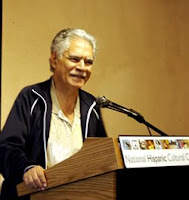
Then comes a major treat, a tour of el torreón, a watchtower Yeats would have loved, made all the more so with the breathtaking mural exectued by Frederico Vigil. The visit, curated by the NHCC's principal fundraiser, Mara Holguin, literally blinded the visitors--no photos allowed, as the center reserves the exclusive control over the process and images. Add this site to El Castillo de Chapultepec and the Reina Sofia in Madrid, who similarly have this strange notion that the public must be restricted in its ability to share what they see.
After the tour, the workshops--the business of the conference begins. With simultaneous workshops running, attenders must pick and choose. I selected prose fiction sessions led by Helen Viramontes, Kathleen Azevedo, and Rolando Hinojosa-Smith.
Kathleen Azevedo's workshop (click for larger view):
Rolando Hinojosa's workshop (click for larger view):

I'm sure the wonderful chow has a lot to do with my forgetfulness. Great acknowledgement and thanks goes to the unnamed staff who tirelessly see to the details that make a conference like this as wonderful and enjoyable as it can be. Obviously enjoying the variety tan rico are Hinojosa and Espada.
La Bloga welcomes your comments on these images, especially if your name is misspelled or omitted altogether. Click here to send your corrections, or más mejor, click below to leave a comment!
Ate,
mvs
Michael Sedano
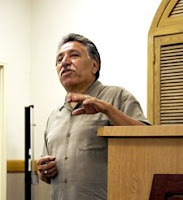
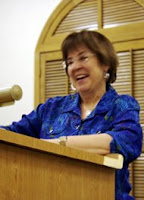
The opening event of the 6th Annual National Latino Writers Conference featured music, readings, and carnalismo. Here are highlights of the events at the Alburquerque Country Inns hotel.
Organizer Carlos Vasquez and staff arranged a satisfying selection of hors d'oeuvres, as well providing a warm welcome. Staff member Greta--apologies to Greta I'll get her full name tomorrow.
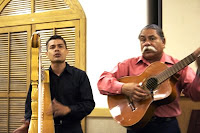 Musical entertainers Los Trinos, Chuy Martinez on guitar and Otilio Ruiz on harp, offered American songs from Chile and New Mexico. The duo played during the pre- and post-meeting gathering as well as their short concert preceding the readings.
Musical entertainers Los Trinos, Chuy Martinez on guitar and Otilio Ruiz on harp, offered American songs from Chile and New Mexico. The duo played during the pre- and post-meeting gathering as well as their short concert preceding the readings.
Helen Viramontes shared an important essay on the role of literature in personal development, including developing a theme that we live our lives as rough drafts, and arts like fiction help us revise, extend, and sharpen our identities. Following the essay, she read an amusing segment from her recent novel, Their Dogs Came With Them, recounting a trio of teenagers wreaking vengeance on a predator jerk.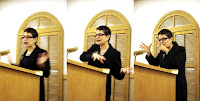 Martin Espada shared a rich selection of poems, principally from his collection Alabanza: New and Selected Poems, 1982-2002, as well as selections from The Republic of Poetry.
Martin Espada shared a rich selection of poems, principally from his collection Alabanza: New and Selected Poems, 1982-2002, as well as selections from The Republic of Poetry.
 Following the readings, while Los Trinos performed, the authors, including surprise guest Alurista, signed their work for enthusiastic readers.
Following the readings, while Los Trinos performed, the authors, including surprise guest Alurista, signed their work for enthusiastic readers.


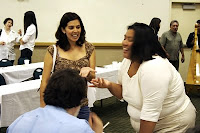
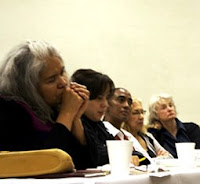
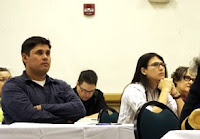
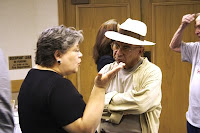
Thursday's activites begin bright and early at 730, continuing throughout the day.



 cultures--perhaps because he was too good at moving in and out of his hispanoparlante cultura and his equally educated Englich, I think—and went on the lam from la jura. Escaping a feared Mexican-killer lawman, Vasquez was pinched in West Hollywood by a local posse. In the newspapers of the day, Tiburcio’s personality won the day, but the jury hanged him anyway, no hard feelings, in 1875.
cultures--perhaps because he was too good at moving in and out of his hispanoparlante cultura and his equally educated Englich, I think—and went on the lam from la jura. Escaping a feared Mexican-killer lawman, Vasquez was pinched in West Hollywood by a local posse. In the newspapers of the day, Tiburcio’s personality won the day, but the jury hanged him anyway, no hard feelings, in 1875.














































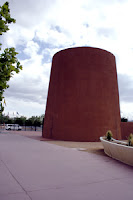
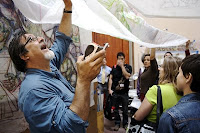
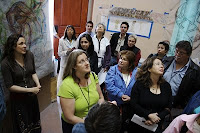
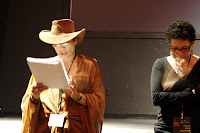




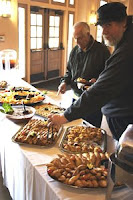












Thanks for a great post. I really enjoyed reading the poetic reponses to Arizona's SB 1070. We should rename SB 1070...the "Que Pinche" Law.
It is actually spelled - "disfruta", (proveniente del verbo "disfrutar")
I love the 'Que Pinche Law' jajaja...and gracias for la 'disfruta,' you're right, just looked it up. When it's said, it SOUNDS like 'desfruta,' I should double-checked, so GRACIAS, Anon... Almaluz